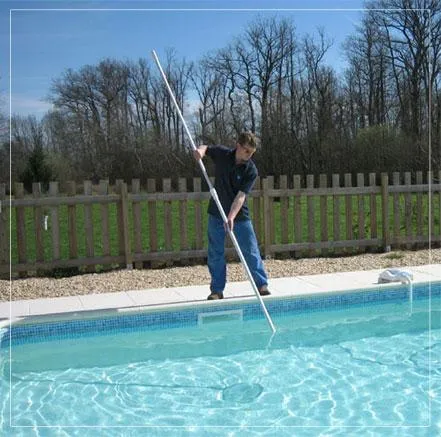July 7, 2022 by HQ Pools

With pool technology advancing more each passing year, many pool owners are investing in high-tech automatic pool vacuums that do all the work for them. However, there are plenty of us left who simply don’t want to commit the money to an automatic vacuum or just enjoy spending the time outside and putting the work in. If you’re one of the latter group, take some advice from us on how to most efficiently vacuum your pool.
EQUIPMENT YOU NEED
Pool Brush
Skimmer Net
Vacuum Head
Telescopic Pole
Vacuum Hose
Water Test Kit
STEP 0: CHECK YOUR FILTER
Before vacuuming your pool, you’ll want to check the pressure on the filter. The ideal number varies from pool to pool, but generally speaking, it should be from 10-20 psi. If the pressure is 8-10 psi higher than normal, you should clean or backwash your filter before you vacuum.
STEP 1: BRUSH AND SKIM
Before hooking up the vacuum, get all the debris that you can with your brush and skimmer. Brushing in every crevice of the pool lifts the dirt and other contaminants out for easier removal by the vacuum, and skimming the surface gets rid of larger pieces of debris that might clog the vacuum hoses.
STEP 2: ASSEMBLE YOUR VACUUM
Your manual vacuum has three parts–the vacuum head, telescopic pole, and vacuum hose. Attach the vacuum head to the telescopic pole with the swivel handle clip, and the hose to the suction port on the vacuum head. Submerge the vacuum head slowly until it is resting on the bottom of the pool.
STEP 3: REMOVE AIR FROM THE VACUUM HOSE
Make sure the hose is able to function properly by removing all the air from it. To do this, start unwinding the vacuum hose and slowly submerging it into the water, working your way to the open end. There should be no more bubbles in the water once it is completely submerged.
STEP 4: ATTACH YOUR VACUUM TO A POOL SKIMMER
If you haven’t yet turned your pool pump off, you can do so now. With the pump off, take your skimmer and attach it to the suction hole at the end of the vacuum hose. If you need to take the hose out of the water to do that, you can prevent air from getting back into the hose by covering the opening with your hand until it’s securely attached.
STEP 5: START CLEANING
Using slow, long, overlapping strokes, vacuum the bottom of the pool. If you go too fast, you may disrupt any debris sitting on the bottom of the pool and cause it to float back up into the water. If that happens, you should wait for it to settle again before you resume vacuuming. As you vacuum, keep an eye on your filter’s pressure gauge. Take a break and backwash it if it gets too high.
STEP 6: DISCONNECT YOUR VACUUM AND CLEAN IT
Once you’re done, pull your vacuum out of the water and clear it of any water that remains in the lines. Your pool level should be about halfway up your skimmer. Test and balance your water chemistry, which might be off if you had to add fresh water into the pool. Rinse your vacuum and all its parts thoroughly with fresh water, then let it dry completely before putting it back in storage.


